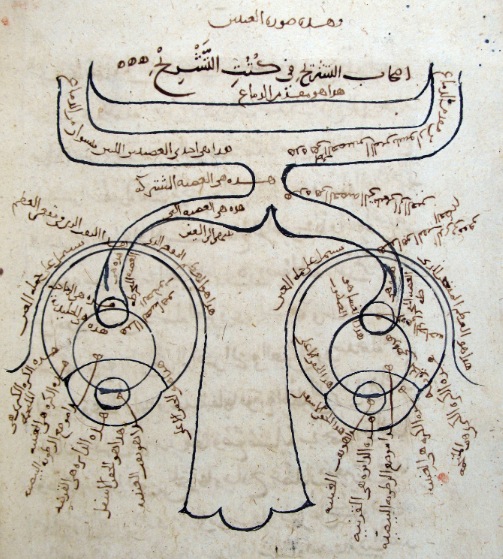The Optics of Ibn Al-Haytham, Books I–III: On Direct Vision (c1028-38/1989)
Filed under book | Tags: · colour, geometry, light, mathematics, optics, perception, physics, vision

This is the first English translation of first three out of the 7 volumes of the fundamental work on optics by the medieval Arab scientist Ibn al-Haitham or Alhazen (965–c1039). His book exerted a great influence upon science through Witelo, Roger Bacon, Peckham and Kepler. Alhazen investigated many particular cases of reflection and refraction, and drew attention to the light-ray’s property of retracing its path when reversed. He was the first to give a detailed description of the human eye and to study binocular vision. Certain ophthalmological terms originated from the Latin translation of Alhazen’s Arabic text, e.g. retina and cornea.
The Book of Optics (Kitāb al-Manāẓir, كتاب المناظر) presented experimentally founded arguments against the widely held extramission theory of vision (as held by Euclid in his Optica) and in favour of intromission theory, as supported by thinkers such as Aristotle, the now accepted model that vision takes place by light entering the eye.
Part 1 contains the translation; Part 2 an introduction, commentary, Arabic-Latin glossaries, concordance, bibliography, and indices.
Edition of the Arabic text, edited by A. I. Sabra, was published by National Council for Culture, Arts and Letters, Kuwait, in 1983 (Books I-III) and 2002 (Books IV-V). Sabra’s translation of the latter has not yet been published.
Translated with Introduction and Commentary by A. I. Sabra
Publisher The Warburg Institute, University of London, London, 1989
Studies of the Warburg Institute, 40/1-2
ISBN 0854810722, 9780854810727
367 and 246 pages, 4 plates (following p. 42 in Part 2)
Review (Alexander Jones, Isis, 1991)
Review (George Saliba, Speculum, 1992)
Wikipedia
Translator
Publisher (WI)
Publisher (SAS)
PDF (pp xvi-xix of Part 2 missing; 18 MB)
Latin translation:
Liber de aspectiibus et vocatur prospectiva (digital facsimile of Latin translation of all 7 volumes, manuscript, Ms 1393)
Opticae thesaurus (edition of the Latin translation by Friedrich Risner, 1572; Archive.org)
See also the first episode of Simon Schaeffer’s 2004 BBC documentary series Light Fantastic, “Let There Be Light”, where he discusses Alhazen and others.
Comment (0)Linda: Brazilian Magazine for Electroacoustic Music, 1-4 (2014–2015) [English, Portuguese]
Filed under magazine | Tags: · brazil, composing, electroacoustic music, music, music criticism

Linda is a magazine launched earlier this year devoted to contemporary electroacoustic music in Brazil and worldwide. Produced by a young collective affiliated with Nova Música Eletroacústica, the issues contain selections from weekly editions.
Magazine website
Music releases on Bandcamp
Issue 1: PDF (EN), PDF (PT; updated on 2017-11-30)
Issue 2: PDF (EN), PDF (PT; updated on 2017-11-30)
Issue 3: PDF (EN), PDF (PT; added on 2017-11-30)
Issue 4: PDF (EN), PDF (PT; added on 2017-11-30)
Iannis Xenakis: Music and Architecture: Architectural Projects, Texts, and Realizations (2008)
Filed under book | Tags: · architecture, composition, computer music, electroacoustic music, electronic music, mathematics, music

“This work fills a major lacuna in the literature by bringing together for the first time all of the projects, realizations and texts related to architecture by the multi-faceted Iannis Xenakis who worked with Le Corbusier for 12 years. Sharon Kanach assisted the composer in gathering the texts for this his last ambitious project.
The material in the book is presented under four main headings: “The Le Corbusier Years”, “Xenakis as Independent Architect”, “Writings on Architecture”, and “The Polytopes”. Three annexes include a commented bibliography of writings by and on Xenakis compiled by Makis Solomo, a critical index of Xenakis’s architecture by Sven Sterken, and a comparative chronology of Xenakis’s life and work by Sharon Kanach. The latter’s commentary throughout the book strives to bridge the reciprocal influences between music and architecture in the Xenakis oeuvre.”
Compiled, Translated and Commented by Sharon Kanach
Publisher Pendragon Press, Hillsdale/NY, 2008
The Iannis Xenakis Series, 1
ISBN 9781576471074
337 pages
via philip
Reviews: M.J. Grant (Music & Letters, 2010), James Harley (MusicWorks, 2010).
PDF (84 MB, no OCR, updated on 2020-9-23)
Comments (2)
